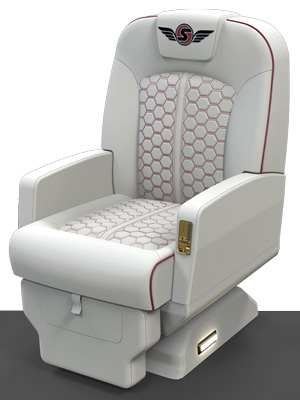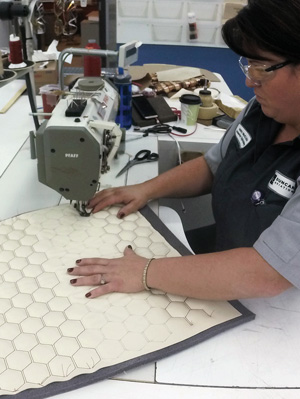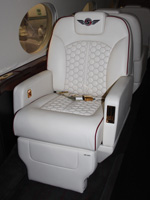
There were great expectations for the interior of this aircraft. As a high-profile charter jet with a stylish paint scheme that flies around the world catching the eye everywhere it lands, the owner wanted the upholstery to have the same “wow” factor.
Not wanting to deliver the same look typically seen on an aircraft, Duncan Aviation’s Design team researched high-performance automotive seats in different shapes and sizes. After several trials and experiments, the designers and upholsterer Niki McClish created a napkin sample with a high-contrast hexagon pattern stitched in bold red on light-colored Townsend Leather in a shade called Venetian Lace. At the same time, they added ½-inch quilt foam, giving the design a three-dimensional effect. This sample and model photos showing the seats and divan trimmed in a red Garrett leather piping were shown to the owner.
He loved it.
The first step of any aircraft interior seating project is to make the design look great on paper. The next is a testament to the skill of a talented team of upholstery specialists when they bring that seat design to life.
Many options were considered about how to complete this labor-intensive project, including seeking an outside vender to machine-stitch the pattern. In the end, quality control and time constraints kept the job in-house.
“It was an easy decision really,” says Designer Ken Reita. “We knew by doing the work here at Duncan Aviation, we maintained strict control of the quality and could work easily within the time constraints of the project. But honestly, it was the level of workmanship in Niki’s sewing samples and the skill of her entire team that sealed the deal.”
Before the first piece of leather was cut, Niki and her team had to overcome the constraints of the dynamic certification. The certified 16G seats required critical load areas (seat cushion and back) to have to have a specific type of foam and density. Ken plotted out the seat design using vendor data and Niki’s input. The rigid, geometric shape allowed for a more computer-aided design, helping Ken to create a very realistic model with correct pattern placement when scaled to actual size.

Guided by hand through an industrial Pfaff sewing machine, Niki McClish, upholstery crew leader at Duncan Aviation's Battle Creek, Michigan, facility, diligently repeats this pattern over and over. This work could be done by a machine, but working with your hands brings out the best quality product in the end.
The hexagon pattern is a pretty straightforward design, but the strict geometric shape required patience and a critical eye to keep the entire seat pattern symmetrical from side to side and top to bottom. Any inconsistencies would be glaring up next to the straight piping that accented each seat.
To guarantee this symmetry, the pattern was laid out on the leather and stitched at the same time as the foam. It was important to do this step by hand because foam allows the leather to shift easily during the sewing process. A machine is not capable of checking its work. If left unattended, the leather can and will move, requiring the entire piece to be re-stitched, wasting valuable time and expensive leather.
This was a hands-on project where the personal touch made a huge impact in the end. Another example is the odd-shaped headrest, which is wider at the top than the bottom. Stretching and wrapping the leather around the foam shape with the company logo centered without wrinkles or gathers takes time and the care of an expert’s hand.
High quality is found in the details, details that are lost if work is done by a machine.

No one person can take credit for the quality of workmanship on these luxurious seats. “It took the entire team to make it happen,” says Niki. “Everyone was excited to tackle a different type of project. We had big discussions about our process, communicated well, and stayed focused.”
These seats were a big challenge when compared to the typical aircraft seat. They were labor-intensive, but they also required a high degree of focus to ensure quality and consistency. The starting point came with the seat foam team creating five shapes that were exactly alike. From these shapes, the leather patterns were created and cut from the best parts of the leather. Pattern makers stitched the foam to the leather and cut the patterns. Several team members stitched the pieces together creating inserts and cushions.

Although complicated, the project went smoothly. Other than a few adjustments along the way, they had no major setbacks. Niki is proud of her team. “Everyone took their job seriously and put their best foot forward. We turned out a great product.”
When the final seats were lined up next to each other in the shop, they looked like carbon copies of an original. The careful modeling, precision stitching, and exact construction were worth the extra time and effort it took.
These seats are destined to travel the world in an aircraft that recently entered the charter market, managed by Metropolitan Aviation.